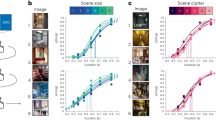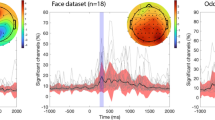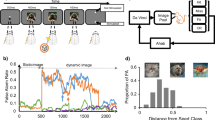Abstract
Just-noticeable differences of physical parameters are often limited by the resolution of the peripheral sensory apparatus. Thus, two-point discrimination in vision is limited by the size of individual photoreceptors. Frequency selectivity is a basic property of neurons in the mammalian auditory pathway1,2. However, just-noticeable differences of frequency are substantially smaller than the bandwidth of the peripheral sensors3. Here we report that frequency tuning in single neurons recorded from human auditory cortex in response to random-chord stimuli is far narrower than that typically described in any other mammalian species (besides bats), and substantially exceeds that attributed to the human auditory periphery. Interestingly, simple spectral filter models failed to predict the neuronal responses to natural stimuli, including speech and music. Thus, natural sounds engage additional processing mechanisms beyond the exquisite frequency tuning probed by the random-chord stimuli.
This is a preview of subscription content, access via your institution
Access options
Subscribe to this journal
Receive 51 print issues and online access
$199.00 per year
only $3.90 per issue
Buy this article
- Purchase on Springer Link
- Instant access to full article PDF
Prices may be subject to local taxes which are calculated during checkout




Similar content being viewed by others
References
Howard, M. A. et al. A chronic microelectrode investigation of the tonotopic organization of human auditory cortex. Brain Res. 724, 260–264 (1996)
Nelken, I. in Integrative Functions in the Mammalian Auditory Pathway (eds Oertel, D., Popper, A. N. & Fay, R. R.) 358–416 (Springer, New York, 2002)
Moore, B. C. J. An Introduction to the Psychology of Hearing Ch. 3 74–114 (Academic Press, London, 1982)
Evans, E. F. in Psychophysics and Physiology of Hearing (eds Evans, E. F. & Wilson, J. P.) 185–196 (Academic Press, London, 1977)
Ehret, G. & Schreiner, C. E. Frequency resolution and spectral integration (critical band analysis) in single units of the cat primary auditory cortex. J. Comp. Physiol. A 181, 635–650 (1997)
Ehret, G. & Merzenich, M. M. Complex sound analysis (frequency resolution, filtering and spectral integration) by single units of the inferior colliculus of the cat. Brain Res. 472, 139–163 (1988)
Heinz, M. G., Colburn, H. S. & Carney, L. H. Evaluating auditory performance limits: I. One-parameter discrimination using a computational model for the auditory nerve. Neural Comput. 13, 2273–2316 (2001)
Fried, I. et al. Cerebral microdialysis combined with single-neuron and electroencephalographic recording in neurosurgical patients. J. Neurosurg. 91, 697–705 (1999)
Banai, K. & Ahissar, M. Poor frequency discrimination probes dyslexics with particularly impaired working memory. Audiol. Neurootol. 9, 328–340 (2004)
Theunissen, F. E., Sen, K. & Doupe, A. J. Spectral-temporal receptive fields of nonlinear auditory neurons obtained using natural sounds. J. Neurosci. 20, 2315–2331 (2000)
Woolley, S. M., Gill, P. R. & Theunissen, F. E. Stimulus-dependent auditory tuning results in synchronous population coding of vocalizations in the songbird midbrain. J. Neurosci. 26, 2499–2512 (2006)
Hsu, A., Borst, A. & Theunissen, F. E. Quantifying variability in neural responses and its application for the validation of model predictions. Network 15, 91–109 (2004)
Read, H. L., Winer, J. A. & Schreiner, C. E. Modular organization of intrinsic connections associated with spectral tuning in cat auditory cortex. Proc. Natl Acad. Sci. USA 98, 8042–8047 (2001)
Gaese, B. H. & Ostwald, J. Anesthesia changes frequency tuning of neurons in the rat primary auditory cortex. J. Neurophysiol. 86, 1062–1066 (2001)
Qin, L., Kitama, T., Chimoto, S., Sakayori, S. & Sato, Y. Time course of tonal frequency-response-area of primary auditory cortex neurons in alert cats. Neurosci. Res. 46, 145–152 (2003)
Moshitch, D., Las, L., Ulanovsky, N., Bar-Yosef, O. & Nelken, I. Responses of neurons in primary auditory cortex (A1) to pure tones in the halothane-anesthetized cat. J. Neurophysiol. 95, 3756–3769 (2006)
Recanzone, G. H., Guard, D. C. & Phan, M. L. Frequency and intensity response properties of single neurons in the auditory cortex of the behaving macaque monkey. J. Neurophysiol. 83, 2315–2331 (2000)
Schwarz, D. W. & Tomlinson, R. W. Spectral response patterns of auditory cortex neurons to harmonic complex tones in alert monkey (Macaca mulatta). J. Neurophysiol. 64, 282–298 (1990)
Miller, L. M., Escabi, M. A., Read, H. L. & Schreiner, C. E. Spectrotemporal receptive fields in the lemniscal auditory thalamus and cortex. J. Neurophysiol. 87, 516–527 (2002)
Tramo, M. J., Shah, G. D. & Braida, L. D. Functional role of auditory cortex in frequency processing and pitch perception. J. Neurophysiol. 87, 122–139 (2002)
Quiroga, R. Q., Reddy, L., Kreiman, G., Koch, C. & Fried, I. Invariant visual representation by single neurons in the human brain. Nature 435, 1102–1107 (2005)
Benasich, A. A. & Tallal, P. Infant discrimination of rapid auditory cues predicts later language impairment. Behav. Brain Res. 136, 31–49 (2002)
Banai, K. & Ahissar, M. Auditory processing deficits in dyslexia: task or stimulus related? Cereb. Cortex 16, 1718–1728 (2006)
McArthur, G. M. & Bishop, D. V. Speech and non-speech processing in people with specific language impairment: a behavioural and electrophysiological study. Brain Lang. 94, 260–273 (2005)
deCharms, R. C., Blake, D. T. & Merzenich, M. M. Optimizing sound features for cortical neurons. Science 280, 1439–1443 (1998)
Schnupp, J. W., Mrsic-Flogel, T. D. & King, A. J. Linear processing of spatial cues in primary auditory cortex. Nature 414, 200–204 (2001)
Theunissen, F. E. et al. Estimating spatio-temporal receptive fields of auditory and visual neurons from their responses to natural stimuli. Network 12, 289–316 (2001)
Mukamel, R. et al. Coupling between neuronal firing, field potentials, and FMRI in human auditory cortex. Science 309, 951–954 (2005)
Bleeck, S., Ives, T. & Patterson, R. D. Aim-mat: the auditory image model in MATLAB. Acta Acustica 90, 781–788 (2004)
Acknowledgements
We thank the patients for their cooperation in participating in the experiments. We thank E. Behnke, T. A. Fields, E. Ho and C. Wilson for technical assistance. This work was supported by an ISF grant (to I.N.), a NINDS grant (to I.F.), the US-Israel BSF fund (R.M. and I.F.) and a European Molecular Biology Organization and Human Frontier Science Program fellowship (R.M.).
Author information
Authors and Affiliations
Corresponding authors
Supplementary information
Supplementary Information
The file contains Supplementary Notes and Supplementary Figure 1 with Legend, on the subjects of response reproducibility and evaluation of STRFs predictive power. (PDF 234 kb)
Rights and permissions
About this article
Cite this article
Bitterman, Y., Mukamel, R., Malach, R. et al. Ultra-fine frequency tuning revealed in single neurons of human auditory cortex. Nature 451, 197–201 (2008). https://doi.org/10.1038/nature06476
Received:
Accepted:
Issue Date:
DOI: https://doi.org/10.1038/nature06476
This article is cited by
-
Large-scale single-neuron speech sound encoding across the depth of human cortex
Nature (2024)
-
Dissecting neural computations in the human auditory pathway using deep neural networks for speech
Nature Neuroscience (2023)
-
Single-neuron mechanisms of neural adaptation in the human temporal lobe
Nature Communications (2023)
-
Single-neuron representation of learned complex sounds in the auditory cortex
Nature Communications (2020)
-
Cortical encoding of speech enhances task-relevant acoustic information
Nature Human Behaviour (2019)
Comments
By submitting a comment you agree to abide by our Terms and Community Guidelines. If you find something abusive or that does not comply with our terms or guidelines please flag it as inappropriate.



